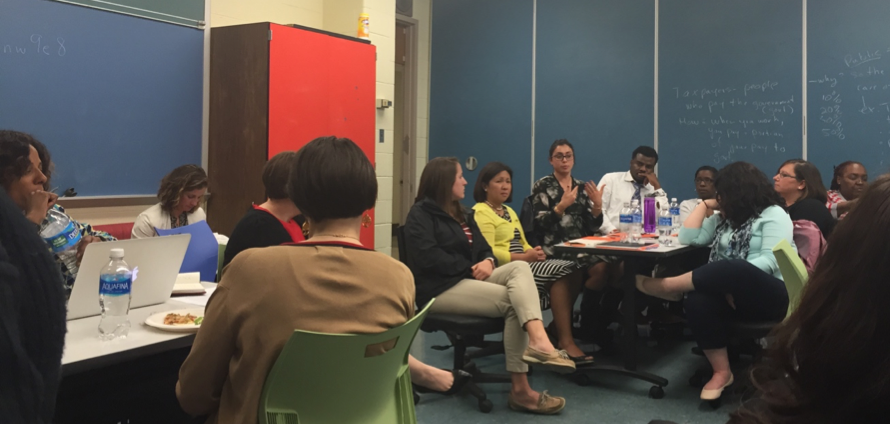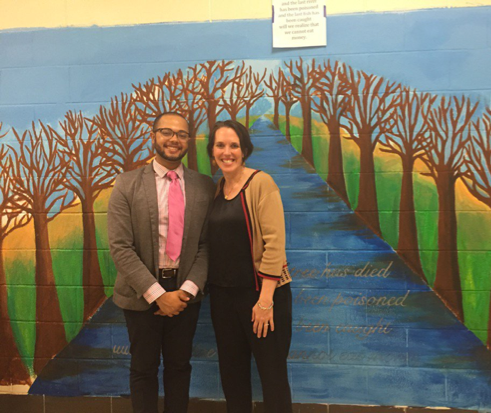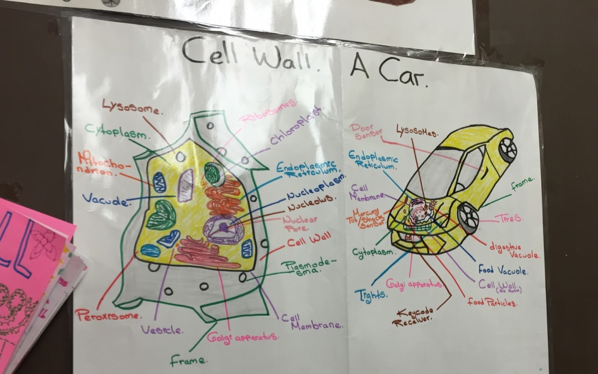Some of the most valuable learning tools in the Springpoint toolbox are our partner schools themselves. That’s why we started organizing school study tours this fall—to celebrate and learn from schools in the Opportunity by Design network. Our first three tours included visits to NYC, Cleveland, and Denver.
The final tour of the school year took place late last month in Prince George’s County, Maryland at two Internationals high schools: IHS Largo and IHS Langley Park. We were joined by nearly 20 educators from the network who were eager to learn from these unique schools. We took a deep look into their work through classroom observations and robust conversations with leaders, students, teachers and social workers.

Study tour participants debriefing classroom visits at IHS Largo and IHS Langley Park
These schools are the result of a partnership between the Prince George’s County school district and Internationals Network for Public Schools. Prince George’s County has nearly a third of the English Language Learners (ELLs) in the state of Maryland, many of whom are first generation, coming to the United States with limited formal schooling. To better serve this population of students the district partnered with Internationals Network for Public Schools, whose vision is to ensure all recent immigrant students have access to a quality high school education that prepares them for college, career and full participation in democratic society. Since 1982, they’ve launched 22 schools serving over 7,000 recently arrived young people. The students in their network have standardized test performance, persistence, and college going rates that are routinely significantly higher than their counterparts in other schools.
After receiving funding from the Carnegie Corporation of New York as part of its Opportunity by Design initiative, Internationals worked to open two new high schools in the district in Fall 2015. With support from Springpoint, school leaders Alison Hanks-Sloan and Carlos Beato spent a year designing schools best suited to meet all the needs of their students, both academically and beyond. Many of the students at these schools are recently arrived immigrants or refugees from countries like El Salvador, Honduras, Mexico, Haiti, Iraq, Cameroon, and Afghanistan. Alison and Carlos worked to make their schools more accessible to students and families who are new to the U.S. They engaged families and caretakers who were unfamiliar with navigating the American school system and worked to familiarize them with the enrollment process, their unique school models and the schools’ project-based and mastery approach.

Principals Carlos Beato and Alison Hanks-Sloan
The schools are explicitly designed to serve ELLs and build on Internationals’ approach. Students are grouped heterogeneously regardless of proficiency level, native language or literacy level. Curriculum is interdisciplinary and students spend their time collaborating on authentic projects designed to provide opportunities for students at varying levels of proficiency. Students collaborate on projects and self-select into different roles. More advanced English speakers take the lead on writing, while those beginning to learn English discuss content with their peers and work on presentations.
There are no stand-alone ESL classes at these schools, so every teacher focuses on building both content and language skills. In an ELA class, students identified cultural signals in two paintings by Mexican-American artists. In conversation with their peers, they connected elements in the paintings to stories they’d read in class, and themes of family and identity. The activity helped build students’ skills in both English and thematic analysis.
The schools see their mastery-based approach as a key way to get students to college and career readiness. During our visit, we saw competencies clearly posted in classrooms, and available for students in individualized packets. This transparency helps ensure that students know what they need to master as they move through content at their own pace. Students in an art class at IHS Langley Park focused on a unit on recycled art and all of them were at different levels of completion. Some were researching artists who work in the medium and others were moving on to creating a recycled project of their own.
Student agency and scaffolding are additional tenets of these schools. IHS Largo’s project units follow a “scaffolding cycle” that moves students toward critical thinking. In other words, students start projects with substantial teacher support, then build to collaborative work with peers, and end with tasks that demonstrate independent mastery of competencies.
Student choice and voice are prevalent in the schools as well. Students lead restorative justice circles, participate in a student government and choose their project focus areas. In a science class at IHS Largo, students chose an everyday object—like a car or restaurant—as a model in a diagram outlining the functions of a cell.

Student work hanging in a science class at IHS Largo demonstrates student choice and mastery
The schools also provide critical supports outside the walls of the school, knowing that their students often feel displaced as newcomers to the United States. CASA de Maryland, a community organization focusing on Latino immigration issues and assistance, has been a critical partner in this work, providing a range of social, health, legal and educational services. Social workers in both schools talked about working with students and families on challenges like family reintegration and crisis management. They also help foster relationships with local food banks and connect families to resources from the community, like winter coats for those experiencing winter for the first time.
One study tour participant observed that these schools are much more than schools—they’re close-knit communities where, not only do adults support students, but students support each other. We saw this deep sense of community time and again, as students translated for each other, worked together, talked about their teachers as coaches and mentors, and encouraged their peers in class and out.
We heard from a student at IHS Langley Park, a recent immigrant from Central America, who didn’t enroll in school during his first few months in the U.S. because he didn’t know how. A friend of his recommended the school and helped him enroll. The school and CASA de Maryland supported this student, who spoke no English when he enrolled in January. Less than four months later, his English is improving and he is on his way to mastering competencies with the support of his teachers and classmates.
The two schools empower their learners and instill them with confidence by creating strong educational communities and encouraging students to play an active role in them. One student from Uganda said that he “need[s] to learn English [to] have a voice in this society…it’s important to have a voice in the place you live.”
For more, watch these videos of Principals Alison Hanks-Sloan and Carlos Beato as they discuss the importance of mastery-based learning in their schools.